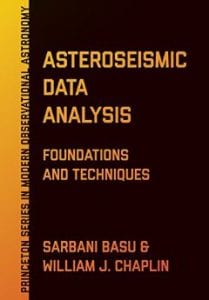Research
“Our telescopes may probe farther and farther into the depths of space; but how can we ever obtain certain knowledge of that which is being hidden behind substantial barriers? What appliance can pierce through the outer layers of a star and test the conditions within”
Sir Arthur Eddington in “The Internal Constitution of Stars” (1926)
There is indeed such an “appliance” and that is asteroseismology (asteros — classical Greek for stars, seismos — classical Greek for tremors, and logos — classical Greek for discourse).
Asteroseismology is the study of stars using their tremors or pulsations. Stars are made of gas that can be easily disturbed, and when disturbed stars pulsate in different modes, each with a different frequency. The frequencies of pulsations can be used to determine the internal properties of stars. The study of Sun using solar oscillation frequencies is known as helioseismology. The main difference between helio- and asteroseismology is the amount of data that can be obtained for a given star. The difference in data, both quality and quantity, translates to different techniques used in the analysis.

An EIT image in the 304 Angstrom wavelength of extreme UV light from each year of nearly an entire solar cycle.
Prof. Basu is an expert in the use of helio- and asteroseismic techniques to study the structure and dynamics of the Sun and other stars. Among her achievements if the characterization of the density and temperature distribution of the solar interior, characterization of solar rotation, and also the study of solar abundances, in particular the abundance of helium in the Sun. Prof. Basu also studies the changes that take place in the Sun over time-scales can affect human society. She uses data from the Global Oscillation Network Group, the Birmingham Solar Oscillation Networ, the Michelson Doppler Imager on board SoHO, and the Helioseismic and Magnetic Imager on the Solar Dynamics Observatory.
Prof. Basu’s research interests include trying to put the Sun in the context of other stars, and to that end she does asteroseismic analyses of other stars with data obtained from NASA’s Kepler and TESS missions.
The publications are available from the links below:
Astrophysics Data System (ADS)
A few selected publications:
Seismology of the base of the solar convection zone ( ![]() )
)
Sarbani Basu
1997, Monthly Notices of the Royal Astronomical Society, vol. 288, page 572
How uncertain are solar neutrino predictions? ( ![]() )
)
John N. Bahcall, Sarbani Basu, M. H. Pinsonneault
1998, Physics Letters B., vol. 433, page 1
Helioseismology and solar abundances ( ![]() )
)
Sarbani Basu and H. M. Antia
2008, Physics Reports, vol. 457, page 217
Fresh insights into the structure of the solar core (![]() )
)
Sarbani Basu et al.
2009, Astrophysical Journal, vol. 699,page 1403
Global seismology of the Sun ( ![]() )
)
Sarbani Basu
2016, Living Reviews in Solar Physics, vol. 13, page 2

